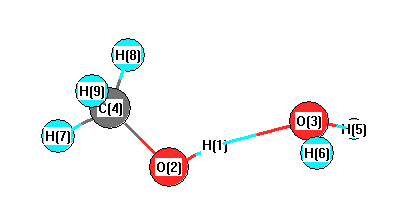Vibrational Frequencies calculated at HF/6-31G*
| Mode Number |
Symmetry |
Frequency
(cm-1) |
Scaled Frequency
(cm-1) |
IR Intensities
(km mol-1) |
Raman Act
(Å4/u) |
Dep P |
Dep U |
|---|
| 1 |
A' |
4070 |
3657 |
36.39 |
|
|
|
| 2 |
A' |
4053 |
3642 |
311.63 |
|
|
|
| 3 |
A' |
3286 |
2952 |
69.81 |
|
|
|
| 4 |
A' |
3174 |
2852 |
72.22 |
|
|
|
| 5 |
A' |
1823 |
1638 |
109.47 |
|
|
|
| 6 |
A' |
1666 |
1497 |
2.06 |
|
|
|
| 7 |
A' |
1639 |
1473 |
14.16 |
|
|
|
| 8 |
A' |
1558 |
1400 |
64.22 |
|
|
|
| 9 |
A' |
1208 |
1086 |
10.87 |
|
|
|
| 10 |
A' |
1200 |
1078 |
126.48 |
|
|
|
| 11 |
A' |
267 |
240 |
282.69 |
|
|
|
| 12 |
A' |
162 |
146 |
13.96 |
|
|
|
| 13 |
A' |
62 |
55 |
52.09 |
|
|
|
| 14 |
A" |
4181 |
3756 |
89.74 |
|
|
|
| 15 |
A" |
3214 |
2888 |
113.62 |
|
|
|
| 16 |
A" |
1652 |
1485 |
0.35 |
|
|
|
| 17 |
A" |
1292 |
1161 |
3.99 |
|
|
|
| 18 |
A" |
684 |
614 |
190.50 |
|
|
|
| 19 |
A" |
207 |
186 |
0.03 |
|
|
|
| 20 |
A" |
90 |
81 |
10.55 |
|
|
|
| 21 |
A" |
66 |
59 |
66.81 |
|
|
|
Unscaled Zero Point Vibrational Energy (zpe) 17776.7 cm
-1
Scaled (by 0.8985) Zero Point Vibrational Energy (zpe) 15972.4 cm
-1
See section
III.C.1 List or set vibrational scaling factors
to change the scale factors used here.
See section
III.C.2
Calculate a vibrational scaling factor for a given set of molecules
to determine the least squares best scaling factor.
Charges, Dipole, Quadrupole and Polarizability
Charges from optimized geometry at HF/6-31G*
Charges (e)
| Number |
Element |
Mulliken |
CHELPG |
AIM |
ESP |
| 1 |
H |
0.486 |
|
|
|
| 2 |
O |
-0.778 |
|
|
|
| 3 |
O |
-0.874 |
|
|
|
| 4 |
C |
-0.156 |
|
|
|
| 5 |
H |
0.450 |
|
|
|
| 6 |
H |
0.450 |
|
|
|
| 7 |
H |
0.159 |
|
|
|
| 8 |
H |
0.131 |
|
|
|
| 9 |
H |
0.131 |
|
|
|
Electric dipole moments
Electric dipole components in Debye
(What's a Debye? See section
VII.A.3)
| |
x |
y |
z |
Total |
| |
2.762 |
0.655 |
0.000 |
2.839 |
| CHELPG |
|
|
|
|
| AIM |
|
|
|
|
| ESP |
|
|
|
|
Electric Quadrupole moment
Quadrupole components in D Å
Polarizabilities
Components of the polarizability tensor.
Units are
Å
3 (Angstrom cubed)
Change units.
| |
x |
y |
z |
| x |
0.000 |
0.000 |
0.000 |
| y |
0.000 |
0.000 |
0.000 |
| z |
0.000 |
0.000 |
0.000 |
<r2> (average value of r
2) Å
2
| <r2> |
99.998 |
| (<r2>)1/2 |
10.000 |
